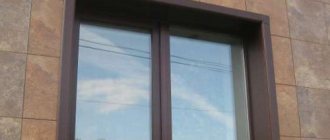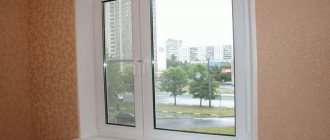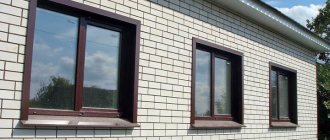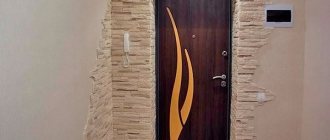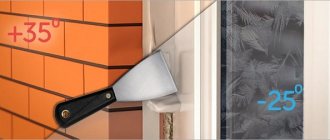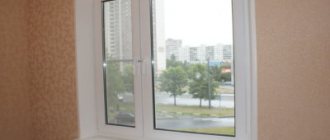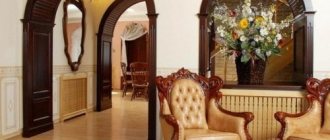Foam plastic slopes: material features and work technology
The main task of slopes is to protect housing from moisture and prevent heat loss.
Not so long ago, it was customary to seal slopes with plaster and concrete mortar. But, over time, the concrete solution begins to crumble, the slopes become unattractive and do not properly protect the apartment from external factors.
Today, covering and insulating window slopes with foam plastic is gaining more and more popularity. Next, we will tell you why the material is so good, and also describe in detail the installation technology.
Expanded polystyrene or polystyrene foam: what to choose
However, you should not confuse expanded polystyrene and polystyrene foam, since they have a number of differences between themselves. The materials differ from each other:
Water absorption. Expanded polystyrene absorbs moisture exactly 10 times less. Why is this so important? It is moisture that provokes the destruction of the material, increasing its weight. Thus, the structural load on each fastening element increases proportionally. At the same time, a wet surface releases heat at a higher rate, which means it is preferable to choose a material with the lowest water absorption coefficient.
Thermal conductivity. It is this parameter that is one of the determining ones when assessing the effectiveness of insulation. Expanded polystyrene is significantly superior to polystyrene foam and can reduce heat loss by 27-46%. Against the background of low density and light weight, the thermal conductivity of polystyrene foam is at the level of 0.028 W/(m.K). Therefore, we consider this material an ideal choice for insulation.
Tensile strength. Everyone wants the process of insulating slopes to be as effective and justified as possible, and for the insulated structure to serve for a long time. This is why we recommend using polystyrene foam, as it is 5 times superior to polystyrene foam. This is true not only for tensile strength, but also for compression. The operation time of polystyrene foam is also 2-5 times faster than polystyrene foam.
The advantages of polystyrene foam when designing slopes
A window slope is a specialized system that can close the opening that forms between the window frame and the facade. It is customary to make slopes after replacing the window unit. As we have already said, the purpose of installing slopes is moisture and heat insulation. Few specialists, after installing a new window unit, suggest immediately making slopes. But, due to such negligence, the polyurethane foam (the material on which the window unit is supported) quickly dries out, gaps form, etc.
Window slopes made of foam plastic
Previously, to seal slopes, craftsmen used various construction solutions, such as plaster, but such finishing material was not particularly reliable. Also, many people prefer plastic panels, but this material is absolutely not suitable for such work, because atmospheric influences can deform it. Today, slopes made of plastic, foam and metal, which have the following advantages, are becoming increasingly popular:
- They last a long time in use.
- Resistant to rust.
- Not deformed.
- Excellent retention of heat in the house.
- Easy to install.
- They have an attractive appearance.
Insulating window slopes: useful recommendations
In some regions, climatic conditions are particularly harsh. Severe frosts and winds cool down living spaces in winter. In such a situation, many owners of apartments and private houses take adequate measures for thermal insulation. The latter is carried out in different areas of the building, including window structures. In particular, insulating slopes will help preserve precious heat in the house.
How were windows thermally insulated before?
Until recently, drafts and blow-outs arising from defects in window openings were eliminated using a variety of improvised means. These included small rags, special paper, medical cotton wool, and adhesive tape.
Although this method provided the desired effect and was easy to implement with your own hands, the aesthetic appearance of the window after it was not the best. For example, when removing the same tape, entire pieces of wooden window coverings often came off. To fix the problem, the damaged surfaces had to be repainted.
This also applies to paper glued over frame slots. As for cotton wool and rags, such “heat insulators” often need to be picked out, they fit so tightly into the corresponding holes.
It is clear that it is advisable to leave such methods of insulating window structures in the past. They bring nothing but trouble. Not to mention that the slopes do not insulate at all. Meanwhile, these functional elements are of great importance when it comes to protecting plastic windows from the inside from the cold. What to do? The answer is obvious - use modern heat insulators.
Necessary materials
Although there are a lot of materials on the market for insulating the slopes of plastic windows, the following insulators are most often used: foam plastic, expanded polystyrene, mineral wool or thermal liners. Another option is insulation with a layer of polyvinyl chloride.
Insulation made of polyvinyl chloride.
The materials presented have proven themselves to be excellent. Today they are recommended to be used by all specialized specialists involved in professional thermal insulation of buildings both outside and inside.
Thermal insulation with thermal liners
Insulating slopes in this way allows you to ultimately obtain perfectly insulated plastic windows from the inside. Where to begin?
Execution of work
Before proceeding directly to insulation work with your own hands, it is necessary to carefully examine the design of both the plastic windows themselves and the external wall surface. The order in which construction activities are carried out largely depends on this. In general, the insulation process is based on the use of thermal inserts.
Thermal liners are mounted on window slopes from the inside. After laying and secure fastening, plastering is carried out. Following this, cladding is performed. For this purpose, sheet-type finishing materials are used.
The size of thermal liners is calculated based on the thermal conductivity of wall structures. An important role is played by the type of thermal insulation material and the location in which the insulated window block is located.
In order for slope insulation to meet generally accepted standards, the material must be tightly applied to the surface of the slopes. Bloating and the formation of an air layer are considered unacceptable.
Sealing
To prevent the appearance of a layer of air and swelling, special adhesives made in the form of mastic are used. The solutions cover the perimeter of the surface being treated and the seams. If there are several compositions, which is possible, coating should be done separately. Proper application of the glue will subsequently ensure tight adhesion to the slope.
Foam insulation
To insulate slopes outside the building with your own hands, it is recommended to use polystyrene foam. The sheet material is cut into strips of the required width and pasted over previously cleaned external window openings. This creates a technological barrier in relation to the slopes from inside the house, which prevents the appearance of condensation.
After the structure has dried, plastic window frames are installed. The cracks are clogged with polyurethane foam. Slopes insulated from the outside with polystyrene foam require mandatory plastering.
To ensure thermal insulation of indoor slopes, it is necessary to cover them with foam plastic from the inside around the plastic windows.
Work progress
Slope insulation is carried out using the following technology:
- a sheet of foam plastic is glued to the slope;
- all cracks are filled with solution;
- A reinforced mesh is attached to the foam on top;
- the structure, insulated with foam plastic, is plastered, then painting work is carried out.
What are the features of polystyrene foam?
Polystyrene foam is a very common building material, which is increasingly used to insulate walls and even ceilings. Its main advantages are:
- affordability;
- environmental friendliness;
- resistance to the influence of external stimuli.
The table below shows the characteristics of the foam.
Slopes on windows made of polystyrene foam allow you not only to insulate your home, but also to make metal-plastic windows more attractive. Such material does not rust during operation and does not deform.
Important! According to the DIY installation technology, insulating slopes with polystyrene foam is very similar to installing drywall. But, if drywall is used exclusively as an internal finishing building material, then polystyrene foam can be safely used outside. You can make slopes from foam plastic inside the apartment, as well as slopes from foam plastic from the outside, as soon as the mounting foam, which is used to fill the voids after installing the window block, has dried.
When making window slopes with your own hands from foam plastic, please note that you need to fix the canvas along the entire perimeter of the window, also under the window sill. The main condition during finishing is to apply putty in more than one layer. Do not use an excessive amount of adhesive solution, because as a result of exposure to high temperatures, the foam will expand, after which cracks will appear. Due to such troubles, the structure will lose not only its thermal insulation properties, but also its attractiveness.
DIY polystyrene slopes (video)
Preparatory work
Regardless of which insulation method and type of material are chosen, first of all it is necessary to conduct a visual inspection of the window structure and carefully check the condition of the installation seams. If the double-glazed window was installed a long time ago, and the installation seam was not protected, then most likely the foam has already begun to collapse and crumble. You can identify problem areas using a lighter. Run it along the entire perimeter of the window. Where the flame deflects is where the leak occurs. These areas need to be cleaned and re-foamed. After hardening, cut off excess polyurethane foam.
List of required materials and tools
And so, in order to finish the external or internal slope, you will need the following devices:
- Construction mixer for mixing the solution.
- Drill.
- Putty knife.
- Level.
- Knife (painting knife).
- Brush.
Necessary tools for installing slopes
To seal slopes, the following materials will be useful:
- Assembly adhesive.
- Foam sheets.
- Special dowels for fixing material (parachutes).
- Fiberglass mesh.
- Primer mixture.
- Perforated corner (for decorating corners).
Now you can start insulating and decorating window slopes.
Preparatory process and cutting of finishing material
Before insulating slopes with polystyrene foam, you need to correctly cut the sheets. The size of the slope is closely related to the dimensions of the window, so you need to understand that they will have to be “planted” as deep as possible.
After cutting the parts, they are connected to each other with glue, which is applied to the seams. Then the glued product is left for a short time. Next, the prepared fragments are connected, pressing firmly, and left for 60 minutes to dry completely.
Fiberglass reinforcement
To achieve maximum strength, fiberglass reinforcement can be done. To do this, fiberglass is cut into strips, the width of which corresponds to the width of the slope. Fix the tapes with a stapler and then secure them with glue. When the glue dries, it is customary to putty the reinforcement, as shown in the photo above.
Plastering window slopes
Quick and high-quality plastering of slopes of plastic windows in St. Petersburg is one of the important stages of almost any repair. A competent master can perform such work quickly and at a high level.
| Surface area | Cost of work | Turnkey cost |
| Walls (up to 100 m2) | 35,000 rub. | from 60,000 rub. |
| Walls (100 - 300 m2) | 250 rub./m 2 | from 500 rub./m2 |
| Walls (300 - 700 m2) | 240 rub./m 2 | from 480 rub./m2 |
| Walls (from 700 m 2 ) | 230 rub./m 2 | from 460 rub./m2 |
| Ceilings (up to 300 m2) | 350 rub./m2 | from 600 rub./m2 |
| Ceilings (from 300 m2) | 340 rub./m2 | from 580 rub./m2 |
| Slopes (with dawn angle) | 300 rub./m.p. | from 450 rub./m.p. |
| Additional services | ||
| Mesh installation | 50 rub./m2 | from 80 rub./m2 |
| Surface area | Cost of work |
| Walls (up to 100 m2) | 35,000 rub. |
| Walls (100 - 300 m2) | 250 rub./m 2 |
| Walls (300 - 700 m2) | 240 rub./m 2 |
| Walls (from 700 m 2 ) | 230 rub./m 2 |
| Ceilings (up to 300 m2) | 350 rub./m2 |
| Ceilings (from 300 m2) | 340 rub./m2 |
| Slopes (with dawn angle) | 300 rub./m.p. |
| Additional services | |
| Mesh installation | 50 rub./m2 |
It is important to understand that finishing a window slope and opening with plaster, as a rule, is done not only inside the building, but also outside. And without certain skills, such tasks may simply be impossible. In addition, only experienced people will correctly select the materials suitable for a particular case in order to achieve the highest quality result.
Aligning the window slope
In most cases, it is more profitable to entrust the alignment of the window opening to specialists. After all, it is carried out for the following purposes:
- improving the thermal and sound insulation of the room (if this measure is carried out correctly, condensation will not form inside the building);
- hiding all kinds of installation elements (even with very careful execution of the previous stages, it is impossible to obtain an ideal result without subsequent finishing);
- giving a harmonious look to the entire room (lime, gypsum and other solutions, unlike plastic and drywall, allow you to achieve a smooth, uniform surface that is airtight and aesthetically pleasing).
If you plaster window slopes without flaws, this will guarantee the durability of the repair and a comfortable microclimate at the site.
- Leveling openings with plaster
- Machine plastering of slopes
- Plastering door
Plastering window openings
If you are interested in such a service as plastering the slope of a window (opening), then turning to specialists is the right decision. is ready to offer Clients very favorable terms of cooperation, including:
- affordable prices (our company’s policy involves analyzing the market and taking into account the purchasing power of citizens when compiling price lists);
- prompt implementation of any projects (a full staff of competent craftsmen and the availability of modern equipment allows us to take on tasks of varying complexity and solve them in a timely manner);
- excellent quality of work at each facility (the use of certified materials and strict adherence to process technology makes it possible to avoid problems in the future);
- consultations with experienced and competent managers (you can contact them with any questions and get quick answers).
We know how to ensure that the plastering of openings after installing windows in St. Petersburg is completed quickly and looks presentable for a long time. Contact our consultants and place your order!
Instructions for installing slopes indoors
Well, now we come directly to the solution to the question “How to make slopes on polystyrene foam windows?” Before starting installation, you need to prepare the place for subsequent work, namely, clean the surfaces from dust, plaster all damaged areas using a plaster solution. Then, if the surface is not smooth enough, it needs to be primed and then given time to dry.
Applying adhesive solution to foam plastic
When the foam is cut and the slopes are prepared, you can begin. An adhesive mass is applied to the inner surface of the foam and a fragment of material is fixed in the required area. Try to press the foam sheet against the surface as hard as possible, and check your actions with a building level to be sure that the glued fragment is even.
Despite the fact that today there are a lot of different adhesives on the construction market (and the prices for them are also very different), which are considered very reliable, do not be lazy to secure the slopes with dowels, but after the glue has dried.
Window slopes reinforced with dowels
After this, the foam plastic is puttied, and all gaps and irregularities are carefully covered so that there is not the slightest loophole for moisture and winds. Then the entire surface is treated with starting putty, reinforcement is applied, which is pressed into the solution that has not yet dried. To avoid damage to the corners, install a perforated corner on them. After the solution has dried, another layer of finishing putty is applied, then the slope can be painted or plastered.
Why do you need to insulate window slopes?
Insulation of slopes outside and inside is an almost obligatory stage of installation of the structure. Finishing slopes using insulation allows you to solve several problems at once:
- Firstly, it provides thermal insulation. The gaps between the edge of the opening and the window block must be covered with a material with low thermal conductivity. If this is not done, then heat loss around the perimeter of the window will increase, which will reduce the energy-saving effect of installing modern metal-plastic windows.
- Secondly, finishing with insulation also ensures tightness. In this case, the gap is completely closed, providing protection not only from blowing, but also from moisture or dust. Moisture here is the most dangerous - it not only increases the thermal conductivity of insulation, but also contributes to the corrosion of metal fasteners, as well as the gradual destruction of the edges of the window opening.
- Thirdly, finishing the slopes with their thermal insulation and compliance with DSTU standards makes it possible to normalize the temperature and humidity conditions in the room. This, in turn, reduces the risk of fungal damage to structures and the appearance of condensation on the profile and/or double-glazed windows.
Thus, insulating slopes when installing a metal-plastic window is a necessary procedure designed to protect against heat loss and ensure an optimal microclimate in the room.
Important! Insulated slopes outside and inside the premises need to be finished. Finishing not only gives the structure a complete and stylish appearance, but also provides thermal insulation materials with protection from moisture and other external factors.
Technology of installation work when designing external slopes
External slopes made of foam plastic are an equally popular option for finishing windows on the street side. For these purposes, it is better to use polystyrene foam, because its technical characteristics and density are several times higher.
Mixing glue with a drill with a mixer attachment
Before you start decorating the slope or platband, you need to select the most suitable glue. Any private and experienced builder will tell you that the best option is Ceresit ST-85. Before work, the glue is thoroughly kneaded until it thickens so that its structure allows it to flow over the spatula.
Now, for maximum adhesion between the surface and the foam sheet, rub the glue into the wall. Then we cover the pre-prepared product with the same glue, choosing a spatula with teeth for the work.
Peculiarities
You can begin installing foam plastic immediately after installing the windows, after you have foamed the cracks. It is the foam plastic that will allow you to insulate your structure as much as possible, and you definitely won’t regret it.
The main disadvantage of this type of work is considered to be the puttying that follows, which not everyone likes. So, to make slopes from polystyrene foam with your own hands, you may need certain tools and materials, and we’ll find out which ones now, but before you start work, you still need to choose the windows.
We insulate ourselves outside
How to insulate the slopes of plastic windows from the street? First of all, you should decide whether you need to carry out work in:
- Private home?
- Apartment?
In the latter case, if the apartment is located above the second floor, it will be unsafe to do this.
In the case of high-rise insulation of slopes, it is better to involve hired specialists.
If you need to insulate window openings at a low altitude, it is still possible to insulate the slopes of plastic windows yourself.
Follow the same sequence as given for internal insulation, with the exception of the last point.
You are unlikely to attach drywall from the outside, so initially you can not install a profile, but simply glue the foam plastic with glue and secure it with fungi. After this, apply the adhesive composition to the foam sheet and embed the reinforcing mesh in this composition. It will hold the structure. All that remains is to plaster the slopes and, perhaps, in the case of a private household, make some decorative elements, for example, lay tiles.
Tools and materials
So, you will need the following tools:
- Attachment - mixer for mixing
- Drill
- Cape spatula
- Notched trowel for applying glue
- Building level
- Painting knife
- Brush
And here are the materials:
- Installation adhesive
- Styrofoam
- Parachutes (dowels for fastening)
- Fiberglass mesh
- Primer
- And for finishing corners - perforated corner
So, let's start making polystyrene slopes with our own hands.
Technology of work on the internal slope
To begin with, prepare the slopes yourself. They need to be cleared of debris and the cracks covered with cement mortar. Next, apply the primer with a brush to the entire surface. While the primed surface dries, we prepare the blanks (cut them to size).
Then, an adhesive solution is applied to the surface of the foam plastic with a notched trowel, and the workpiece is pressed against the slope. You can immediately pick up a building level, checking how level the installation is, because if the surface is uneven, this will significantly complicate the installation of windows. For a clearer installation, we recommend fixing the foam plastic to dowels at several points, then the plate will definitely not move away from the slope.
The only thing is that you will carry out the fastening to the dowels only when the glue has dried, since if it does not set, you can easily ruin the installation.
Next, all the foam plates are installed, with careful joining. If possible, you can additionally putty the joints to ensure that there are no gaps.
Now we apply the starting putty to the surface, attach the reinforced mesh, and apply the finishing layer of putty on top. So the internal slopes made of polystyrene foam are ready. What about the outside ones? Let's take a look now!
Insulation of window slopes from the outside
In this case, work is carried out in conjunction with the installation of insulation on the external walls of the building. Most often, foam or mineral wool is preferred for this task. The method of fixing both materials is not much different from each other. Insulation of window slopes with polystyrene foam should be done as follows:
- Initially, surface areas must be cleaned of all debris and dust. If there are poorly held pieces of the base, they should be knocked down and remade. Excess foam needs to be trimmed.
- The entire surface must be covered with a deep penetration primer with antibacterial properties.
- The next step is to cut the insulation in accordance with the dimensions of the slopes. In this case, it is necessary to use slabs with a thickness of 2 cm and a density of 30-35. To increase the level of adhesion to the surface, the material can be slightly scratched with a needle roller.
- Next, you need to apply a special adhesive composition to the workpieces and glue them to the surface.
- Next, in the corners, you need to install perforated corners on the same mixture.
- Upon completion, it is necessary to glue the reinforcing mesh onto the surface of the foam plastic using plaster.
Insulation of slopes around windows with mineral wool should be done in the same way.
Installation of an external slope
You can also make external slopes from foam plastic. By doing this, you kill two birds with one stone - both the windows look great and are insulated, and if you choose warm windows, then you will significantly save heat in the house.
You just need to use glue for exterior work, such as Ceresit ST-85 or 83.
Mix it thoroughly with water, and it is better to use a drill with a special attachment so that the mixture turns out without lumps. The wall around the opening is primed, then, after drying, rub the glue onto this place. Rubbing is done as follows:
- Apply a small layer;
- And spread it in a thin layer over the surface.
Next, apply glue to the foam plate itself with a notched trowel and apply it to the window.
You need to start the gluing process from the bottom corner, but it is recommended to carefully glue the joints between the foam. After installing all the foam plastic plates with your own hands on the window slopes, you need to carefully fill the cracks.
Next, cover the entire area with fiberglass mesh as standard. We attach a perforated corner to the putty in the corners and apply a finishing layer of putty to the entire area.
After the putty has set, you can prime the surface and then apply paint on top. This is how you can make slopes from foam plastic with your own hands.
Slopes on polystyrene windows: photo instructions
Today we will talk about how to make slopes on polystyrene windows with your own hands. The photos that we have prepared demonstrate that this option for making slopes is quite acceptable. And if we take into account that windows are changing in the country at an incredible speed, then the instructions on the topic “How to make slopes on windows” will be useful to many.
There are a lot of photos and videos on the Internet that teach, show the main points when finishing slopes both indoors and outdoors. However, only practice can prove whether you know how to make slopes on windows. But still, we will try to describe this process in as much detail as possible so that everything becomes clear to you.
What types of slopes are there?
The slope is the end part of the wall that borders the window or door. When installing a new window or door structure, the old slope loses its aesthetics and functionality. Yes, yes, functionality, because slopes on windows are not so much beauty as protection. Firstly, it is necessary to protect the polyurethane foam from exposure to ultraviolet radiation. Secondly, you need to properly close the seam between the window (door) and the slope to prevent moisture from getting inside and eliminate drafts in case of improper foaming.
Slopes on windows can be made in several ways, taking advantage of today's variety of building materials. This can be wood paneling, PVC panels, plasterboard, polystyrene foam or polystyrene foam. You can also limit yourself to simple plastering, which to some extent will even be a better solution. After all, the plaster is applied directly to the slopes, without “stealing” precious centimeters of space. But there are at least two factors that determine the infrequent use of plastering work when finishing the slopes of windows and doors:
- If we are talking about do-it-yourself work, then finishing with plasterboard, wood or plastic panels, polystyrene foam or polystyrene foam is much easier to do than the plastering process. Not everyone can plaster competently and beautifully, especially if we are talking about small slopes, each of which has two corners - internal and external.
- Quite often, when installing a new window, the thickness of the finishing of the future slope is so great that using plaster would be the wrong decision. A layer of a couple of centimeters is quite acceptable, but if we are talking about three, five centimeters or even more, then such a plastered slope can hardly be called durable and of high quality.
Selection of material for thermal insulation of slopes
When choosing a material, you should focus not only on its cost.
It is necessary to use thermal insulation that has the following characteristics:
- low thermal conductivity;
- durability;
- shape stability;
- immunity to temperature changes;
- low hygroscopicity;
- resistance to fungus and mold.
You can insulate the slopes of plastic windows inside the apartment and on the street side with the following materials:
- Styrofoam. It is produced in the form of slabs 100x100x2 cm. It is distinguished by its affordable price, lightness and ease of processing. The disadvantage is that the substance absorbs moisture and, under its influence, loses its properties, slowly turning into dust.
- Extruded polystyrene foam is the most effective insulation among its slab counterparts. Penoplex does not deteriorate from dampness, is immune to pressure and pathogenic microorganisms. It is great for exterior and interior use.
- Mineral wool. Produced in rolls and slabs with thicknesses of 50 mm, 100 mm and 150 mm. The material conducts air well. Mineral wool can be used to insulate wooden and frame houses, where ventilation qualities are valued. Since the insulator is hygroscopic, it must be insulated with membrane fabric, followed by covering with plastic panels or sealing with plaster.
- Polyurethane foam. It is a liquid substance that, upon contact with air, expands 30-40 times, filling all cracks and cavities. Cured foam has low thermal conductivity, resistance to dampness and temperature changes. The disadvantage of polyurethane foam is that it quickly deteriorates when exposed to ultraviolet radiation.
- Sandwich panels. They are an excellent option for finishing slopes both outside and inside. The foam enclosed between the PVC plates is protected from external influences and effectively retains the cold. During installation, it is necessary to properly seal the ends of the panels in order to securely close the filler.
- Warm plaster. Combines the qualities of foam and putty. Thanks to its liquid state, it fills all voids, forming a strong frame for the window. After drying, it is a reliable temperature barrier between the street and the room. Strengthening the insulating properties of the solution is achieved by adding a variety of foam balls, ceramic and polymer additives.
Thermal slope can be created from several types of insulation, if this is necessary to achieve a high-quality result in all respects.
Do-it-yourself installation of polystyrene slopes
The main purpose of the slope is to protect the living space from moisture penetration and to prevent unnecessary heat loss. Previously, plaster and concrete mixtures were used to construct slopes. But concrete has a significant drawback - over time it begins to crumble. Nowadays, polystyrene foam is increasingly used for these purposes.
External slopes made of foam plastic have increased performance properties, do not deform over time and give the house a more attractive appearance.
Why is it worth doing insulation?
First of all, it is worth noting that insulation is an essential part of a high-quality installation of a window system, which subsequently will not only last longer, but will be distinguished by high functionality. The main reasons requiring insulation:
Insulation of slopes protects the window opening from freezing and condensation
In addition to functionality, insulating window slopes will give the structure a stylish appearance that will harmoniously blend with the interior of the room.
Features of foam
Polystyrene foam is a fairly popular material for insulating ceilings and walls. It is characterized by efficiency, environmental friendliness and resistance to negative environmental factors.
This finishing material has a long service life and ease of installation. Foam slopes will make modern metal-plastic windows even more attractive. During operation, the material does not rust at all and is not subject to deformation.
The technology for laying polystyrene foam with your own hands is in many ways similar to creating slopes from plasterboard. But if drywall is used to a greater extent for arranging internal structures, then foam plastic is also suitable for creating external slopes of windows.
You can make slopes immediately after installing new windows and drying the foam. Foam is attached around the perimeter of all windows and under the window sills. The only condition for the effective use of finishing material is the application of several layers of putty.
Do not use large amounts of glue. When heated, the foam can expand, which will cause cracks. And this will entail a decrease in the thermal insulation qualities of the structure.
Ceresite glue is applied to the cut foam strips in a thick layer using a spatula.
To make quality slopes, you will need:
- Styrofoam;
- glue;
- putty;
- primer;
- dye;
- perforated corner;
- fiberglass mesh 5x5 mm;
- rags;
- scotch;
- electric drill;
- construction mixer;
- plastic bucket;
- 2 spatulas: regular and notched;
- roulette;
- level;
- stationery knife;
- brush;
- dowels
Properties and advantages of using polystyrene foam
Polystyrene foam is a universal material that is used in various cases. It has the following distinctive properties:
- Light weight. This makes it possible to carry out work without using additional forces, and also eliminates the need for auxiliary strengthening of surfaces.
- No harm to human health.
- Moisture resistance. The product does not absorb water and does not rot.
Polystyrene foam is a universal material, safe for health and highly moisture resistant.
Naturally, making slopes from this material seems to be a rather original undertaking. But in reality, if all technical parameters are correctly fulfilled, the result is a design that will not be inferior to other existing options. This is facilitated by the advantages of the product:
- Ease of preparation and installation.
- Low cost.
- Durability. The service life is calculated in tens of years.
- Additional insulation of slopes.
Polystyrene foam is a lightweight and practical material that is easy to install.
Although some disadvantages cannot be ignored:
- Lack of resistance to mechanical stress.
- Low air exchange parameters.
- Destruction of properties when processed with incorrectly selected compounds.
Of course, the product does not act as an independent finishing material for slopes. Additional do-it-yourself processing is required, which will give the foam increased strength.
Foam slopes require additional processing
